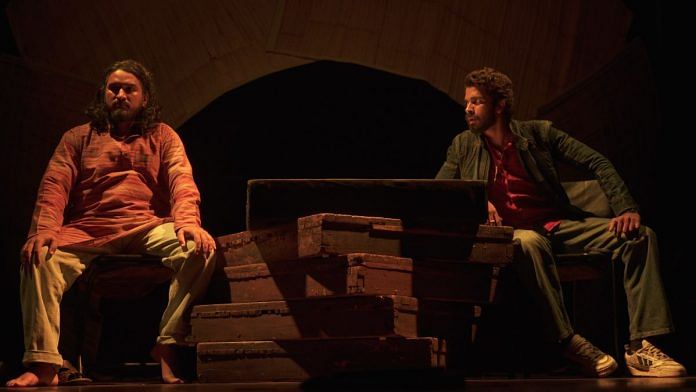New Delhi: The dim lighting enveloped the stage as the two actors engaged in a fierce competition, fighting for the sole ticket to see their idol, Naseeruddin Shah. Their voices clash, their ambitions collide, but the competition ends in vain, both uttering the words, “61 saal theatre ke naam”—61 years in the name of theatre. The audience, holding its breath, joins them in this moment of silence, the moment of reverence.
Much like Waiting for Godot, Waiting for Naseer immerses audiences in the poignant experience of waiting, yet the essence of this waiting tells a different story.
“Bimari ne sirf shareer ko mara, maut toh intezaar karte karte hi hui thi”—The illness only killed the body; death came just from waiting.
The play is about two young actors waiting to meet their lifelong inspiration—the thespian Naseeruddin Shah. Their seemingly endless wait is similar to many other stories where admirers and fans embark on long journeys to meet their heroes. The wait is an artifice to reflect on the state of theatre, artists’ insecurities and hypocrisies, fame and immortality.
Staged at the India Habitat Centre Theatre Festival in New Delhi, ‘Waiting for Naseer’, directed by Srinivas Beesetty and written by Sapan Saran, stands out as a delightful farcical piece about theatre artists. It captivated the audience throughout its 90-minute runtime.
Presented by Kahe Vidushak Foundation and Molecule Talkies, and featuring actors Maulik Pandey, Maahir Mohiuddin, and Naman Roy, this marks Beesetty’s 15th directorial venture. He has directed plays like Panchi and Do Kaudi Ka Khel that together won 20 Theatre National Awards and also acted in a few films including Srikant (2024).
Also read: Akshara Theatre is a Delhi gem, and a lifeline for small artists
The act of waiting
In this play, two struggling actors, calling themselves “anmare” (someone whose physical mortality does not signify their death because their hope remains alive), wait at the Prithvi Theatre cafe to meet the legendary Naseer. Their endless yearning to meet him becomes a metaphor for the greater pursuit of validation and success in an actor’s life.
“While Godot speaks of existential despair and the redundancy of life, Naseer brings hope, celebrating theatre as an art form that provides meaning even amid struggles,” Beesetty told ThePrint.
What does an actor truly have beyond trust—trust that the audience will come, the lights will shine, the words will flow, and the curtains will rise?
Yet, this wait, this ‘intezaar’ becomes a slow poison; the tragedy lies in the fact that even after death, the two actors linger, yearning to meet Naseer and witness his brilliance. For them, he is not just an icon but the very pinnacle of achievement in the realm of theatre.
And the line “Naseer to actor honge na play me, baat badi to natak khega” (Naseer may take the stage as an actor, but it’s the play that will truly leave an impression), whispers a profound truth. No matter who takes the stage, the play transcends the actor. It’s the narrative, the world woven by the writer’s imagination, that reigns supreme.
“Artists have a great ego, and this play exposes the hypocrisy of an artist,” Beesetty said. While the characters are devoted to their craft, their actions betray a deeper longing for fame and approval. They acknowledge this irony, embracing the absurdity of their pursuit and finding humour in their insecurities.
Also read: Shabana Azmi to Naseeruddin Shah, how Bollywood stars breathed life into Delhi’s theatre scene
Challenges of Indian theatre
While Waiting for Naseer is a celebration of theatre, it also touches upon the broader challenges faced by Indian theatre. Beesetty notes the harsh reality of the lack of infrastructure and recognition for theatre artists in India. “Theatre in India survives because of countless passionate individuals who are driven to act and share their stories, despite having no proper spaces like even a park to rehearse,” he said.
As the actors wait for their moment of glory, their journey mirrors the struggle of Indian theatre itself—always searching for that moment of recognition, even when the support system seems non-existent.
“As long as there is rebellion within, art will emerge. Questions arise from rebellion, and stories are woven from those questions,” Beesetty said, highlighting the essence of the character’s journey in the play.
This theme of waiting and longing extends to a side character—the café waiter, who recites a poem about unfulfilled dreams that resonates with the actors. His aspirations, expressed through poetry, are simple yet sincere, untouched by the disillusionment that has crept into the actors’ lives.
सपना देखा घसीटाराम ने
घर हो अपना जमनाबाग में ..
सपना इक दिन पूरा होगा, जिसकी आस में वक्त कटेगा
इंतजार में निकले प्राण, हुआ ना उनसे कोई काम
“वेटर” बना के छोड़ा जग ने, सपना देखा घसीटाराम ने ..
घर हो अपना जमनाबाग में ..
Ghaseetaram had a dream,
To have his own house in Jamnabag.
One day, his dream would come true, waiting for that, time would pass,
Life would drain away in the waiting, as nothing came to be.
The world left him as just a “waiter”, Ghaseetaram had a dream,
To have his own house in Jamnabag.
“In art, there is no right or wrong,” Beesetty said. The poem challenged the actors’ rigid notions and showed them that true art, the kind that comes from the heart, transcends definitions and remains unattainable.
(Edited by Theres Sudeep)




